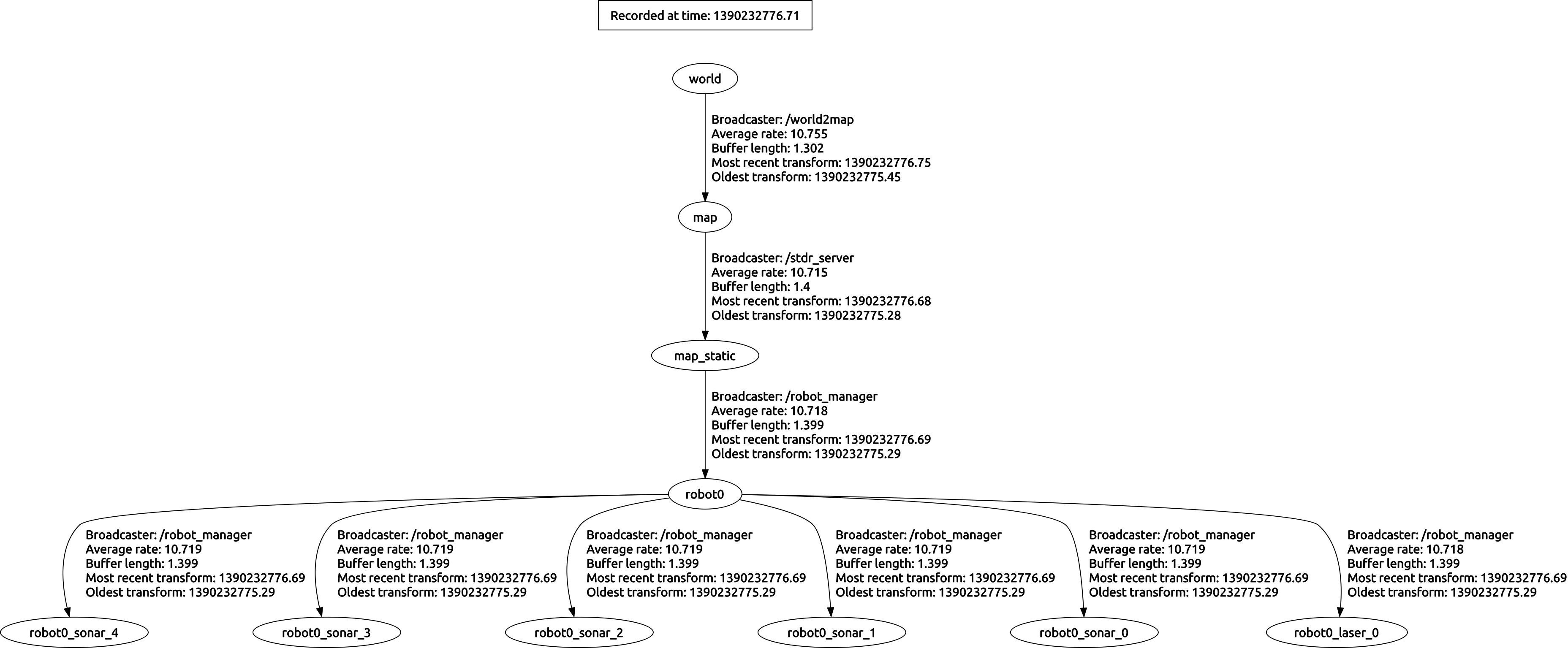Only released in EOL distros:
Package Summary
Provides robot, sensor implementation, using nodelets for stdr_server to load them.
- Maintainer status: maintained
- Maintainer: Chris Zalidis <zalidis AT gmail DOT com>
- Author: Manos Tsardoulias, Chris Zalidis, Aris Thallas
- License: GPLv3
- External website: http://stdr-simulator-ros-pkg.github.io
- Bug / feature tracker: https://github.com/stdr-simulator-ros-pkg/stdr_simulator/issues
- Source: git https://github.com/stdr-simulator-ros-pkg/stdr_simulator.git (branch: hydro-devel)
Package Summary
Provides robot, sensor implementation, using nodelets for stdr_server to load them.
- Maintainer status: developed
- Maintainer: Chris Zalidis <zalidis AT gmail DOT com>
- Author: Manos Tsardoulias, Chris Zalidis, Aris Thallas
- License: GPLv3
- External website: http://stdr-simulator-ros-pkg.github.io
- Bug / feature tracker: https://github.com/stdr-simulator-ros-pkg/stdr_simulator/issues
- Source: git https://github.com/stdr-simulator-ros-pkg/stdr_simulator.git (branch: indigo-devel)
Package Summary
Provides robot, sensor implementation, using nodelets for stdr_server to load them.
- Maintainer status: developed
- Maintainer: Chris Zalidis <zalidis AT gmail DOT com>
- Author: Manos Tsardoulias, Chris Zalidis, Aris Thallas
- License: GPLv3
- External website: http://stdr-simulator-ros-pkg.github.io
- Bug / feature tracker: https://github.com/stdr-simulator-ros-pkg/stdr_simulator/issues
- Source: git https://github.com/stdr-simulator-ros-pkg/stdr_simulator.git (branch: indigo-devel)
Package Summary
Provides robot, sensor implementation, using nodelets for stdr_server to load them.
- Maintainer status: developed
- Maintainer: Chris Zalidis <zalidis AT gmail DOT com>
- Author: Manos Tsardoulias, Chris Zalidis, Aris Thallas
- License: GPLv3
- External website: http://stdr-simulator-ros-pkg.github.io
- Bug / feature tracker: https://github.com/stdr-simulator-ros-pkg/stdr_simulator/issues
- Source: git https://github.com/stdr-simulator-ros-pkg/stdr_simulator.git (branch: indigo-devel)
Contents
Overview
The stdr_robot package implements a simulated robot, all simulated sensors and its simulated motion controller. Till now the following sensors are implemented:
Laser Range Scanner (LIDAR), provides a sensor_msgs/LaserScan.
Sonar, provides a sensor_msgs/Range.
Available motion controllers:
- Ideal motion controller.
The robot class is available using the nodelet interface, named stdr_robot/Robot. To load a new robot a STDR Server has to be running. New robots/nodelets can be loaded only from stdr_server, using either stdr_gui or command-line tools described below.
A parser for YAML and XML files is also provided, to load or save robots, sensors etc. More details on how to use YAML and XML files with stdr_simulator here.
Tf frames
A robot provides tf transforms for the pose of itself and its sensors. All transforms are relative to map_static frame. For more details about map tf frames see STDR Server tf frames. An example with one spawned robot follows (using rqt_tf_tree):

Sensor transforms
The frame_id for each sensor is defined on loading a robot from GUI or when using a YAML/XML file to describe a sensor. Each sensor frame_id has to have a unique name per robot. To avoid naming collisions with other robots it is also (automatically) prefixed with robot's name. Example: robot0_laser_1.
Robot transform
Each robot provides a tf transform with its current pose. The frame_id is automatically assigned and has the format robot<ID>. Example: robot2.
Topics
All topic names are prefixed with robot name. Example robot1/cmd_vel.
Subscribed Topics
cmd_vel (geometry_msgs/Twist)
- Robot listens for velocity commands
Published Topics
<laser_sensor_frame_id> (sensor_msgs/LaserScan)
Publishes laser scan. Example: robot0/laser_back
<sonar_sensor_frame_id> (sensor_msgs/Range)
Publishes sonar measurements. Example: robot0/sonar_2
Services
All services are prefixed with the name robot_manager. This is the name of the nodelet manager and should not change.
load_nodelet (nodelet/NodeletLoad)
- Called to load a new robot.
unload_nodelet (nodelet/NodeletUnload)
- Called to unload/delete a robot.
Command-Line Tools
robot_handler
With the robot_handler command-line tool you can add, delete and move a robot directly from the terminal. The following sections describe the available commands.
robot_handler add
add <description.yaml> <x> <y> <theta>
Adds a new robot at given position (x, y, theta). Needs full path to the description file. Example:
$ rosrun stdr_robot robot_handler add resources/robots/khepera2.yaml 1.2 2 1.57
NOTE: robot_handler does not check if the pose you provided is valid, so you can spawn a robot on a wall, or on top of an existing robot. (This will change in future releases)
robot_handler delete
delete <robot_name>
Deletes a robot named <robot_name>. Example:
$ rosrun stdr_robot robot_handler delete /robot2
robot_handler replace
replace <robot_name> <new_x> <new_y> <new_theta>
Moves a robot to given pose. Example:
$ rosrun stdr_robot robot_handler replace /robot1 1.2 3 3.14
NOTE: robot_handler does not check if the pose you provided is valid, so you can move a robot on a wall, or on top of an existing robot. (This will change in future releases)
Tutorials
For tutorials see stdr_simulator/Tutorials.







